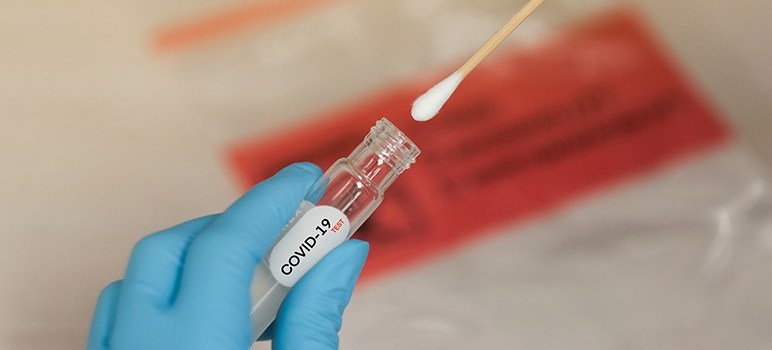Private healthcare systems, which Santa Clara County officials chided for lagging in the effort to boost the pace of COVID-19 testing, have stepped up, but still have a ways to go to match the county totals, according to a new county public health dashboard.
The dashboard unveiled today shows the Kaiser Permanente, which serves 40 percent of all healthcare consumers in the county, conducted 32,682 COVID-19 tests February through June, nearly half of the number of virus tests administered by the county.
County officials last month had complained that public facilities run by Valley Medical Center were handling nearly 90 percent of COVID-19 tests. This prompted the county to order large private health systems to offer free tests on demand.
Many of these large healthcare systems were already making testing available to their patients, but the order requires testing of those who are symptomatic, contacts of known cases, and front-line workers.
“All large healthcare systems in the county need to provide this level of care to those they serve,” the county says on its public health website. “We are heartened to see that healthcare systems are starting to provide increased testing, but more work is ahead.”
The dashboard shows the county averaging a total of more than 4,000 tests per day, its original stated goal. To achieve its new goal of 10,000 tests per day, each of the three private health systems will need to match the county’s daily total.
The new numbers show that the county healthcare system accounted for approximately 30 percent of the 232,899 total tests conducted February through June.
The county public health COVID-19 testing dashboard represents only the testing done on people who live in Santa Clara County.
Since March 4, Stanford’s Virology Laboratory reported it has conducted more than 125,000 tests (which includes nearly 25,000 serology (antibody) tests) at 123 external facilities in 14 counties, as well as at Stanford’s own hospitals and clinics throughout the greater Bay Area.
“We have supported testing for many counties and facilities that have asked for our help,” Stanford said in a statement July 8.
Numbers for July were not yet available.
The new dashboard showed that Stanford Health Care administered 29,759 tests of Santa Clara County residents in the February-June period, Palo Alto Medical Foundation reported 11,802 tests, El Camino Health reported 7, 848, and HCA Healthcare reported 3,468 in the five-month period.
In the same period, private labs Verily and OptumServe accounted for 22,136 and 10,057 tests, respectively. The average turnaround time for all tests was less than two days, according to the county.
The new dashboard will be updated daily, and is available here.


The June 10, 2020 Order of the Health Officer (https://www.sccgov.org/sites/covid19/Pages/order-health-officer-06-15-20.aspx) suggests that the private, for-profit hospital system, as part of the fragmented and uncoordinated system of health care provision in the County, is rather pathetic. In the absence of the legal mandate to conduct COVID-19 testing for anyone seeking such a test, the private hospitals would have continued to service their own, mainly privately-insured, clientele leaving the County facilities with the overwhelming burden of tending the broad public in the midst of a pandemic.
Indeed, the private and for-profit hospitals have been pushing since the first shelter-in-place order was announced on March 17 to return to their elective surgery-driven business model. Several had to furlough medical staff and/or reduce their salaries at the same time (https://sanjosespotlight.com/are-south-bay-hospitals-ready-to-perform-elective-surgeries-amid-covid-19/). Is there anything more illogical and preposterous than hospitals laying off medical staff during an unprecedented public health emergency?
It says a lot about what “health care” has become in this country as the lobbyists of profit-driven insurance, hospital, pharmaceutical and medical device corporations have captured Congress and, therefore, shaped “public” health policy in favor of commercialized care. Is there any better case for a national health insurance system that covers everyone for all necessary care as determined by physicians and medical professionals (not insurance company adjusters)?
Such a system would pool current premiums, combine these with additional revenues from payroll taxes and/or additional taxes on the wealthy, and would be able to cost-effectively bargain for services from all providers and vendors on behalf of all users? Such a system would also save an estimated 68,000 lives, 1.7 million life-years and nearly a half-trillion dollars ($450,000,000,000) per year relative to our current system. More than 90 percent of U.S. households and businesses would see significant health cost savings under such a rational public plan (see https://www.thelancet.com/action/showPdf?pii=S0140-6736%2819%2933019-3).
That system is precisely the one envisioned under HR 1384, introduced in the U.S. House of Representatives in January 2019. That bill currently has about 119 co-sponsors. Of 10 Bay Area House representatives (all of them Democrats), only Nancy Pelosi and Anna Eshoo officially oppose this plan (so too does Joe Biden, a majority of Democratic Senators, Donald Trump and the vast majority of Republicans in the Congress).
> Indeed, the private and for-profit hospitals have been pushing since the first shelter-in-place order was announced on March 17 to return to their elective surgery-driven business model.
Well, DUH!
“Private and for-profit” healthcare providers are a DIFFERENT THING than public healthcare services.
It’s like complaining that golfers do a lousy job as football players. So?
The problem is NOT that private healthcare providers do a lousy job as public healthcare facilities.
The problem is that the PUBLIC healthcare services have been over-promised and do a lousy job at what people think they are supposed to be doing.